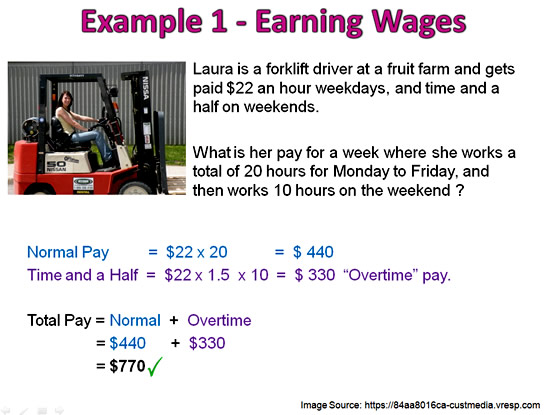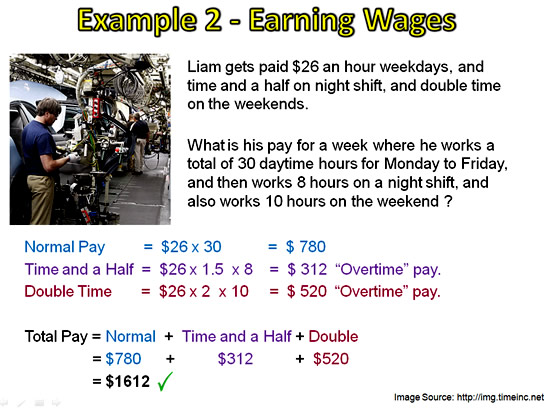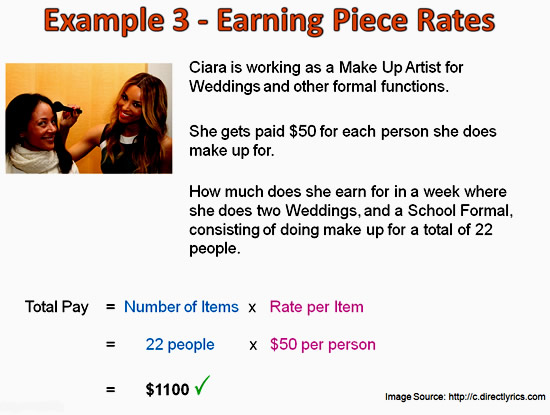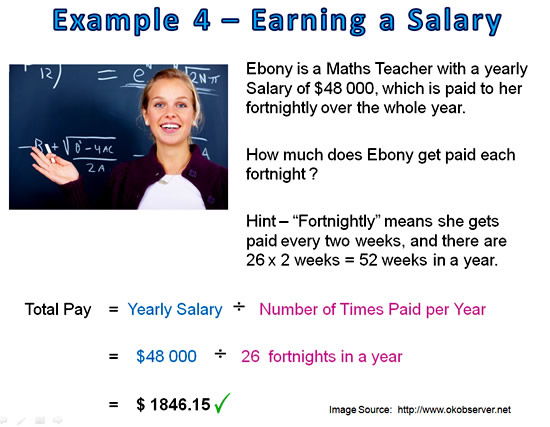
Image Source: http://www.moneyedup.com
It would be great if money just fell out of the sky like rain whenever we needed it; but unfortunately this is not the case! Most people have to get jobs and earn money.
People work, (or are “employed”), in certain jobs so they can earn money which is called an “Income”.
“Income” basically means incoming money for doing paid work during the week.
Payment for jobs can occur in different ways, depending on the agreed working conditions for the type of job.
Types of Payments

Image Source: http://www.thenobhillcasino.com
There are four main types of Payment for jobs:
Wages, Piece Work, Salary, and Commission.
Often the type of payment depends on the job type.
For example, Trades workers are usually on “Wages”, while Sales people work on “Commission”.
Wages
Payment by wages involves a fixed Hourly Rate of Pay for a standard set number of hours. Hours worked beyond these set hours, or beyond set times of the day (eg. Night shift), are paid as “Overtime” at a higher than normal daily rate.
“Overtime usually involves “Time and a Half”, (where 1.5 times the normal hourly rate is paid), or “Double Time”, (where twice the normal hourly rate is paid for each hour worked.
Types of jobs where people are paid Wages are Trades Jobs (Plumber, Carpenter, Electrician, Welder, Mechanic, Hairdresser, etc).
Wages are also generally paid for Retail Jobs (Shop Assistant, Shelf Stacker, Cleaner, Fast Food worker, etc)
Wages are also often paid for Factory Jobs (Assembly Line Worker, Fork Lift Driver, etc)
Examples of Payment involving Wages are given later in this lesson.
Piece Work
In this type of work, people are paid for each item that is produced or processed, rather than for the number of hours worked.
Types of jobs where people can be paid by “Piece Work” are in manufacturing (dress maker, furniture maker, fruit and vegetable picker, footwear maker, hand bag or hat maker, dog groomer, dog walker, etc)
Couriers and Truck Drivers can also be paid by “Piece Work” based on how many items they transport or deliver.
Examples of Payment involving Piece Work are given later in this lesson.
Salary
This type of Income involves Weekly, Fortnightly, Monthly, or Annual rates of pay. Workers are often required to work overtime, but it is rarely paid. Instead time off may be given (if you are lucky enough to have it written into your employment conditions).
People who work on Salary are often Professionals such as Doctors, Lawyers, Engineers, Scientists, Accountants, Politicians, and Teachers.
Commission
For income earned by Commission, workers are paid a small “Retainer” or “Flat Fee” plus either a percentage of the dollar value of the Sales they make, or else a certain amount for each sale they make.
Jobs which have Commission pay are usually Sales jobs such as Real Estate, Car Sales, Sales Reps for Manufacturing companies, Book Sellers, Mortgage Brokers, and Insurance Consultants.
Examples of Payment involving Commission are given later in this lesson.
There are no fixed rules set in concrete for how some occupations are paid. For example someone might be a Computer Programmer paid an hourly rate, or maybe they are only paid for building one particular App, no matter how many hours it takes them.
Somebody else might be a Physiotherapist and either paid based on how many patients they see, or instead they may be paid a fixed hourly or daily rate.
Usually what determines how an employee is actually paid is a set of agreed working conditions that exist between “Employer” (the Boss) and the “Employee” (the worker).
Agreed Working Conditions

Image Source: http://cdn.singersroom.com
There are three main types of agreed working conditions :
Awards, Agreements, and Contracts
These documents spell out quite clearly what work needs to be performed, the usual hours this work is done in, and the basic pay structure for this work.
Awards
An award is a legal document that sets out minimum wages and conditions for an industry or occupation.
Awards cover things as rates of pay, overtime, penalty rates, and allowances for travel, meals, etc.
The conditions in awards apply on top of the minimum conditions in the Australian National Employment Standards.
For more information about Awards in the Australian workplace, (especially to find out if you are being paid correctly), check out the following web page:
http://www.fairwork.gov.au/awards/pages/default.aspx
Agreements
An agreement is like an award created specifically for the employees of a particular company.
An agreement must be at least equal to the corresponding award.
A typical “Work Agreement” includes:
The names of the parties involved in the agreement, (eg. Employer and Employee)
The start and end dates of the agreement
The articles to which each party agrees, (eg. the work that is to be done by the employee, and the ways in which the employer will provide equipment and facilities to help this work to get done)
The details of the agreement such as compensation (pay), benefits (sick leave, holidays, etc) and repercussions (poor work performance, unapproved absences, etc).
Contracts
People doing very specialised work (like a programmer building an App or Web Pages, or a builder organising the construction of a home, or a Surveyor mapping out a new housing estate, a band making an album), will sign a contract for the work they do.
The Contract will link to a Project Plan Timeline, and detail what work needs to be completed by what dates, and how much will be paid upon completion of each stage of the project.
People on Contract often have to organise their own equipment and materials, working hours, sick pay, and holidays, as these are not usually part of the signed Contract.
Calculating Wages Videos
The following set of videos, (watch them one after each other), show detailed examples of how to calculate Wages and Overtime.
Example 1 – Earning Wages
Image Source: https://84aa8016ca-custmedia.vresp.com
Laura is a forklift driver at a fruit farm and gets paid $22 an hour weekdays, and time and a half on weekends.
What is her pay for a week where she works a total of 20 hours for Monday to Friday, and then works 10 hours on the weekend ?
Break the question up into normal pay and time and a half. Work out each component, and then total everything up for the final answer.

Image Copyright 2012 by Passy’s World of Mathematics
Example 2 – Earning Wages

Image Source: http://img.timeinc.net
Liam works on an assembly line making cars.
He gets paid a combination of Normal Pay, Time and a Half, and Double Time, as shown in the following example week’s pay.

Image Copyright 2012 by Passy’s World of Mathematics
Example 3 – Earning Piece Rates

Image Source: http://c.directlyrics.com
Ciara is working as a Make Up Artist for Weddings and other formal functions.
She gets paid $50 for each person she does make up for.
How much does she earn for in a week where she does two Weddings, and a School Formal, consisting of doing make up for a total of 22 people.

Image Copyright 2012 by Passy’s World of Mathematics
Example 4 – Earning Salary

Image Source: http://www.okobserver.net
Ebony is a Maths Teacher with a yearly Salary of $48 000, which is paid to her fortnightly over the whole year.
How much does Ebony get paid every two weeks ?

Image Copyright 2012 by Passy’s World of Mathematics
Example 5 – Earning Commission

Image Source: http://img.thesun.co.uk
Tom is starting out as a Car Salesman and earns a Base Salary of $400 a week. He then gets 5% Commission on any Cars that he sells.
What is his weekly pay for a week in which he sells 3 cars totalling $120 000 in value ?

Image Copyright 2012 by Passy’s World of Mathematics
Calculating Commission Videos
The following video includes several examples including a multi-part graduated commission situation.
Help Passy’s World Grow
Each day Passy’s World provides hundreds of people with mathematics lessons free of charge.
Help us to maintain this free service and keep it growing.
Donate any amount from $2 upwards through PayPal by clicking the PayPal image below. Thank you!
PayPal does accept Credit Cards, but you will have to supply an email address and password so that PayPal can create a PayPal account for you to process the transaction through. There will be no processing fee charged to you by this action, as PayPal deducts a fee from your donation before it reaches Passy’s World.
If you enjoyed this lesson, why not get a free subscription to our website.
You can then receive notifications of new pages directly to your email address.
Go to the subscribe area on the right hand sidebar, fill in your email address and then click the “Subscribe” button.
To find out exactly how free subscription works, click the following link:
If you would like to submit an idea for an article, or be a guest writer on our website, then please email us at the hotmail address shown in the right hand side bar of this page.
Feel free to link to any of our Lessons, share them on social networking sites, or use them on Learning Management Systems in Schools.
Enjoy,
Passy


